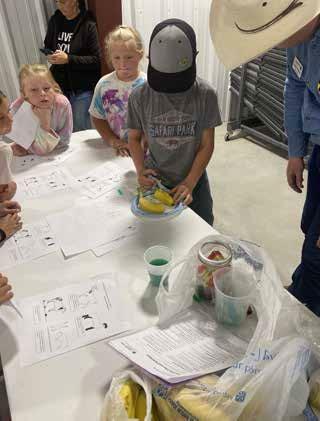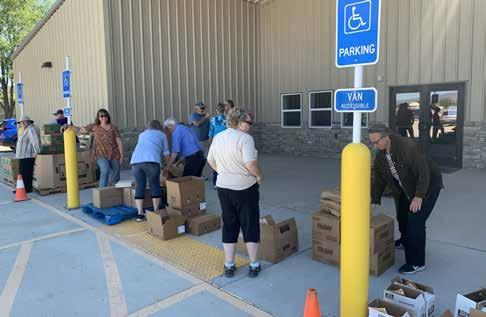
9 minute read
4-H Day camp
The Oneida County Extension Office held its annual Livestock Day Camp for the 4-H youth of the area Monday, June 14. In attendance were more than 60 4-H students that will be taking market steers, hogs and lambs to the county fair in August. The presentations of the Livestock Day Camp were tailored to help them in their animal projects over the summer.
Samatha and Cassidy Schrenk began the presentations by discussing sheep showmanship. They taught about the various parts of showing sheep, including things like teaching lambs to lead, fitting the lambs prior to showing and how to present them during the show. Following their discussion, they gave a live demonstration of sheep showmanship. This was a good opportunity to point out important tips for showing, such as how to hold the lamb while showing, when to stand in regards to the judge and how to set up a lamb.
Oneida County Ag Educator Sawyer Fonnesbeck gave a presentation on animal health and vaccinations and using proper injection sites and techniques when treating sick animals. The students learned the many ways that cattle, swine and sheep can be treated when they become sick, including medications given with an injection.
Injections can be given subcutaneously, or under the skin, or intramuscularly, or in the muscle. Needles specific for each type of injection, help ensure that the medication is delivered to the appropriate site. Injections should be administered in an animals’ neck and should be avoided in the rump areas. The students practiced their newly learned techniques by injecting their syringes into a banana, noticing the difference of placing their medications just beneath the skin or into the meat of the banana.
Kord Killpack, the Bear Lake County Extension Agent, taught students about carcass grading and what they need to do to raise their animals to provide the very best meat cuts possible. The students were taught that carcasses are graded by measuring the amount of marbling in the ribeye found between 12th and 13th rib. A carcass with a high amount of marbling is graded prime, a carcass with a fair amount of marbling is graded choice, and a carcass with little marbling is graded select. The marbling fat, fat that makes meat tender and flavorful, is found intramuscularly and scattered amongst the muscle fibers. Intermuscular fat, fat that is tough and chewy, is found between muscle groups and most often cut off. Marbling is primarily determined by two things, the animals genetics and feed. The students created their own steaks from red licorice and marshmallows to demonstrate what makes each grade of steak.
Bracken Henderson of the Franklin County Extension Office led a discussion on good sportsmanship as 4-H competitors, particularly when it comes to writing thank you notes. The students were reminded that while they were indeed selling their market animals like other producers do, there is a large portion of their earnings that individuals and businesses give to support them in their projects- the floor price (market value) vs the actual selling price. Because of the generosity of the buyers, all 4-H youth should make time to write a respectful and sincere Thank You note. These notes should include the 5 G’s- a Greeting, Gratitude for support, Goals for earnings, Gratefulness for generosity and an appropriate Goodbye.
Justin Hatch-Caribou County Extension Educator presented a final discussion of the importance of animal housing. After talking over the important components of animal housing, including a shelter, feed, water and an appropriately sized pen, the students designed their own pens using toy animals, panels, bunks, and shelters. Visualizing the placement of the various elements helped them learn important things like keeping their feed away from where the animals drink and poop and about having the right amount of space for each animal type or the number of animals.
Learning these important lessons of showing animals, giving injections, designing an appropriate housing facility, evaluating meat carcasses and having good ethics by appropriately thanking buyers will help these 4-H students to be more successful as they carry out their market animal projects over the next several months as they prepare for the Oneida County Fair.
Using red licorice and marshmallows, the youth created their own meat cuts that would be graded based on its marbling to learn about carcass quality 4H youth learned about vaccinating their animals and the importance of using proper injection sites and techniques as their administer any medication. They practiced their new skills by injecting bananas

Food Bank Offers Food Security Services
A Discussion with Mary Young
The local food bank is a valuable community support institution which provides food to over 100 families a month. Local Food Bank Co-ordinator Mary Young explains: “The Mobile Food Bank is nothing new, just the drive through service that was initiated in 2020 when the COVID Panic began. I know the program existed in 1984 when my parents brought 7 kids to live with my Grandma for 5 months while they renewed their teaching certificates. I remember my Grandma cooking lima beans and macaroni and cheese from processed cheese blocks that were distributed there at that time. I also remember the half gallon jugs of honey that had a USDA label on them.
The Mobile Food Bank is one of the Programs supported by the Idaho Food Bank. Our Local Food Pantry, Carol's Pantry is a sister to it. The Idaho Food Bank sends out Mobile Pantries all over Eastern Idaho every month to assist residents in Rural areas. Downy, Pocatello, Fort Hall, and other communities around us also have Mobiles that come once a month. Our Mobile arrives on the 2nd Thursday of each month to the Fairgrounds every month but August when the County Fair is happening. In August, we change venue to the High School Student Parking Lot. Usually the distribution begins about 10:00 am and ends at 11:30, or sooner if we run out of commodities.”
Carol's Pantry is located by the Airport and distributes Tuesdays and Thursdays from 10:00 till 2:00 the 3rd and 4th weeks of the month.
Maty Young took the time to answer a few additional questions about the Food Bank: Who funds/supports the program?
The Food that comes each month is provided by Government Programs and also by Charitable Donation. The USDA purchases food from farmers and production facilities at minimal or no cost. The Church of Jesus Christ of Latter Day Saints frequently donates potatoes and dairy products. Albertsons and Costco donate expired but frozen bakery items. Melaleuca has donated hams and turkeys at Thanksgiving time. Glanbia, Chobani, Cliff Bar, and Ore-Ida are other companies that donate food. Most of the canned goods gathered from Community Food Drives ends up in the Food Pantries, not the Mobiles.
Volunteers are the key to making the Food Banks work. The volunteers in the Eastern Branch equate to 7 full time employees. There are Full Time employee opportunities, but not many here in Malad. The Mobiles are strictly distributed by volunteers. I arrange for between 10 to 13 volunteers each month.
Starting in 2020, the Idaho Food Bank started "Temporary Emergency Food Assistance Program" (TEFAP) in the Mobile Pantries. Since that time, we are required to ask for household income information on our forms. We do not discriminate on income, or any other criteria. Anyone can come and pick up an order. With a signed note from the beneficiary, we will also allow a person to pick up an order for someone else. To allow access of assistance to everyone in the community, we limit the number of orders picked up by one car to 2 orders, unless there is no line. We figure that orders can be shared if we happen to run out. The only criteria we discriminate for is State Residency. Who is eligible?
Anyone. One order per household.
We gather names, addresses and other information about those who use the service. This is strictly used to provide demographic data. Do you have regular housing?, TEFAP eligibility, Is this your first time attending the Mobile?, and household size and age information. You have to provide this information to receive an order.
The Idaho Food Bank uses the demographic information to track the number of meals distributed with the food they supply us.

Volunteers, including Co-ordinator Mary Young, on hand to distribute food for the Food Bank What are some reasons people might use this service?
There are so many reasons. Some just come because it's fun to see what they get. We have a lot of seniors who are on limited incomes. There are also grandparents with custody of grandchildren, We have many large families and single parent families that appreciate a little help. We have even had some homeless individuals attend.
I have heard many voice concern recently about the rising price of gasoline and food. I am expecting that our numbers will continue to increase in the coming months. What would you like the community to know about the program? How can people help if they would like to?
I encourage people to attend the Mobile Food Bank if they are interested in getting help with groceries. We may run out of food if everyone comes immediately, but get in line anyway. We will only ask for more if we can prove with numbers that we need it. The Food Bank usually sends us one or two items that outlast everything else. Chances are, there will be something for everyone. I recommend coming before 11:00. We usually start cleaning up when the line is gone. If you wish to volunteer, message me on Facebook. We don't need many, I usually count on the ones who show up month after month. Occasionally, I have recruited new faces when I have figured out the night before that we are short. If we ever go back to the old way of doing things, we will need to double the staff. Because it is summer, many of you will probably have surplus garden produce. We could distribute for you if you bring it to us. What do you feel is the most important impact of the program on the local community? I think the biggest impact is that it promotes sharing; good deeds are contagious. We don't tell people what to do with the food that is given to them in their order. I have witnessed enough order sharing on the day of Food Bank that I know the program is benefitting so many more people than we get down on our paperwork. About half the orders we see are by community members picking up for someone else, ministering to someone or a family that can't come for themselves. I think it is wonderful that they help out this way. Everyone leaves with a smile and no one complains about the service or the prices!




